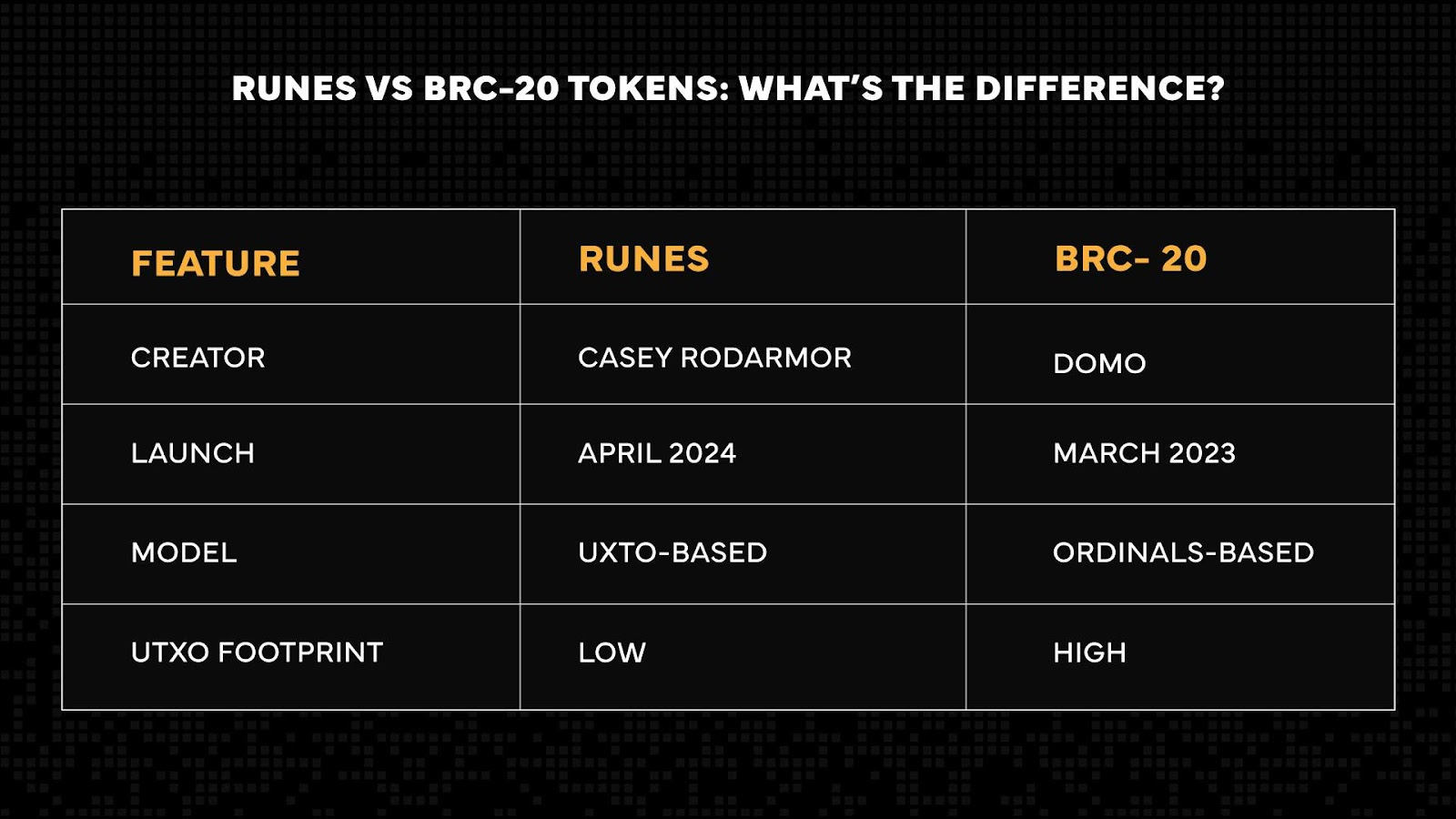Bitcoin
Bitcoin CPI
Venture Portfolio
Funds
Market Insights
Indicators
About
Contact

September 6, 2025





One of the most recent developments in the Bitcoin ecosystem has been the launch of the Runes Protocol. This is a standard for creating fungible tokens on Bitcoin.
Read on to learn what Bitcoin Runes are, why the Bitcoin Runes protocol was created, how it works, and how it could change the Bitcoin ecosystem.
Runes is a new Bitcoin token standard designed by Casey Rodarmor as an alternative to the BRC-20 protocol, in making it possible to create fungible tokens on the Bitcoin network.
The Runes Protocol follows an Unspent Transactions Output (UTXO) model where each transaction is created by picking up pieces of Bitcoin change that have not been spent.
Unlike the BRC-20 protocol, which leaves behind excessive “junk” UTXOs after each transaction and therefore clogs the network, Runes uses a more efficient model for creating fungible tokens on the network.
Runes is the latest attempt at creating the go-to standard for token development on the Bitcoin network.
The limitations of the BRC-20 protocol motivated Rodarmor to develop the Runes Protocol. He was particularly interested in resolving BRC-20 standard’s heavy UTXO footprint, which often led to network clogging.
But what are UTXOs, and why are they such a concern within the BTC network?
UTXO is the change you receive from the Bitcoin network after sending a specific amount of BTC.
For example, when you spend $90 for shopping and pay using a $100 bill, the merchant will hand you $10 as change and keep the $100 bill as it is. However, in the Bitcoin network, the network keeps the “$100 bill,” releases a new $90 to the merchant, and issues another $10 to you, instead of splitting the $100 into $90 and $10.
When this happens on the Bitcoin blockchain, we say the “$100 bill” represents the initial UTXO, then the network goes ahead to create a new UTXO for the $90 payment, which is sent to the merchant and also creates another new UTXO for the $10 change which the network sends back to you.
As such, UTXOs can be referred to as the collective units that make up your BTC balance in your wallet.
The challenge with BRC-20 is that every transaction creates “junk” UTXOs, which can pile up quickly. And when that happens, they create bottlenecks in the network, resulting in higher transaction fees that negatively affect all network users, not just those trading BRC-20 tokens.
But that shouldn’t be an issue with Runes, which has implemented efficient and more organized ways of utilizing the Bitcoin blockchain to prevent creating unnecessary UTXOs, enabling faster transactions and lower fees.
Compatibility with the Bitcoin networks means the Runes Protocol uses BTC transactions to create and transfer tokens. Here's how it works:
The process of creating a Rune token is known as etching. It starts by creating a special Bitcoin transaction with an OP_RETURN output. To do so, protocol messages called Runestones are used and stored as BTC transactions.
The creator assigns the new Rune properties such as a name, symbol, transaction ID, divisibility, minting terms, supply, and block height. Additionally, the creator attaches the Rune to a specific UTXO.
Once the creator finishes etching the Rune, they move it to the minting stage. Here's where the actual token is generated per the set terms. The protocol supports open minting as long as it adheres to the etching terms. Upon completion of this process, the token will be ready for transfer.
The third step involves transferring the Rune from a transaction input to an output. For that, you will use an edict, which is a message detailing that switch. These edicts carry the token’s output number, ID, and amount. Runestones can have an infinite number of edicts, which also come in the OP_RETURN format.
There are occasions where Runestones may have errors, such as missing outputs or inaccurate encoding. These are known as cenotaphs. The Runes protocol burns any token having them, with the intention of encouraging users to be diligent.
Though they have a few aspects in common, Runes and BRC-20 tokens are fundamentally different. Here are a few of their distinctive traits:

The first key difference between the Runes and BRC-20 tokens is in their creators. Rune was created by Casey Rodarmor, a well-known Bitcoin developer, while the BRC-20 protocol is the work of a pseudo-anonymous developer called Domo.
The BRC-20 protocol launched in March 2023 and is, therefore, older than Runes, which debuted in April 2024.
Whereas Runes is UXTO-based, BRC-20 runs on the Ordinals protocol. Furthermore, Runes has a low UXTO footprint and burns any tokens created from transactions with errors. In contrast, BRC-20 has a high UXTO footprint and allows users to correct any errors in their transactions.
What’s more, both standards support open minting, but Runes also allow closed and pre-minted configurations, offering creators greater control.
The Runes ecosystem has grown beyond memecoins. It now features marketplaces, minting apps, lending platforms, and more.
To trade Runes tokens, users need a marketplace or DEX that supports the protocol. These platforms list tokens from creators and allow users to buy, sell, or swap Runes by connecting their wallets. Magic Eden and Odin.fun are are examples of popular Runes trading platforms.
Creating a token on the Bitcoin network used to require technical expertise. The Runes protocol and new minting tools have made the process far more accessible. Users can now create Runes tokens through dedicated minting apps, such as Xverse or Luminex.
Interestingly, you can also use Runes tokens as collateral in the DeFi lending markets to access Bitcoin liquidity, thanks to the Bitcoin-native lending app, LiquidiumWTF. There, you can deposit Runes tokens as lending collateral to borrow BTC on-chain on a peer-to-peer basis.
The launch of the Runes Protocol has paved the way for developers to create fungible tokens on Bitcoin, opening up the world’s most secure blockchain for a more vibrant token economy.
As a result, we can expect to see more use cases in the Bitcoin blockchain as it moves past its store of value and medium of exchange features to become a more versatile blockchain.
We can also expect more network activity as more developers and token traders come to Bitcoin.
Finally, we could see more investors and users coming to Bitcoin as the network’s digital currency becomes the transactional currency of the building on the Bitcoin movement.
The Runes Protocol proposes new ways of structuring, organizing, and managing token issuance on the Bitcoin network by redefining how tokens are created on the network.
As the token economy on Bitcoin continues to grow, it will be interesting to see what role the Runes token standard will play.
Ordinals and Runes are both token protocols on Bitcoin. While Ordinals enable the creation of unique digital assets akin to NFTs, the Runes protocol enables the creation of fungible tokens, similar to the ERC-20 token standard in Ethereum. Both protocols leverage the security and decentralization of the Bitcoin network, paving the way for new use cases on Bitcoin.
No, Runes tokens are not the same as BRC-20 tokens. While both standards operate on the Bitcoin network, Runes and BRC-20 are fundamentally different. BRC-20 is based on inscriptions and stores data within individual satoshis, while Runes use the UTXO model and don’t rely on inscriptions.